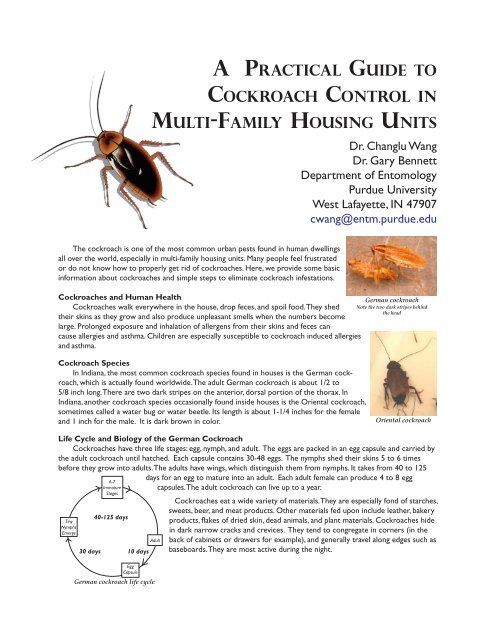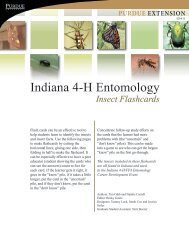Community-wide cockroach IPM in public housing - Purdue ...
Community-wide cockroach IPM in public housing - Purdue ...
Community-wide cockroach IPM in public housing - Purdue ...
Create successful ePaper yourself
Turn your PDF publications into a flip-book with our unique Google optimized e-Paper software.
A PRACTICAL GUIDE TO<br />
COCKROACH CONTROL IN<br />
MULTI-FAMILY HOUSING UNITS<br />
Dr. Changlu Wang<br />
Dr. Gary Bennett<br />
Department of Entomology<br />
<strong>Purdue</strong> University<br />
West Lafayette, IN 47907<br />
cwang@entm.purdue.edu<br />
The <strong>cockroach</strong> is one of the most common urban pests found <strong>in</strong> human dwell<strong>in</strong>gs<br />
all over the world, especially <strong>in</strong> multi-family hous<strong>in</strong>g units. Many people feel frustrated<br />
or do not know how to properly get rid of <strong>cockroach</strong>es. Here, we provide some basic<br />
<strong>in</strong>formation about <strong>cockroach</strong>es and simple steps to elim<strong>in</strong>ate <strong>cockroach</strong> <strong>in</strong>festations.<br />
Cockroaches and Human Health<br />
German <strong>cockroach</strong><br />
Cockroaches walk everywhere <strong>in</strong> the house, drop feces, and spoil food. They shed Note the two dark stripes beh<strong>in</strong>d<br />
the head<br />
their sk<strong>in</strong>s as they grow and also produce unpleasant smells when the numbers become<br />
large. Prolonged exposure and <strong>in</strong>halation of allergens from their sk<strong>in</strong>s and feces can<br />
cause allergies and asthma. Children are especially susceptible to <strong>cockroach</strong> <strong>in</strong>duced allergies<br />
and asthma.<br />
Cockroach Species<br />
In Indiana, the most common <strong>cockroach</strong> species found <strong>in</strong> houses is the German <strong>cockroach</strong>,<br />
which is actually found world<strong>wide</strong>. The adult German <strong>cockroach</strong> is about 1/2 to<br />
5/8 <strong>in</strong>ch long. There are two dark stripes on the anterior, dorsal portion of the thorax. In<br />
Indiana, another <strong>cockroach</strong> species occasionally found <strong>in</strong>side houses is the Oriental <strong>cockroach</strong>,<br />
sometimes called a water bug or water beetle. Its length is about 1-1/4 <strong>in</strong>ches for the female<br />
and 1 <strong>in</strong>ch for the male. It is dark brown <strong>in</strong> color.<br />
Oriental <strong>cockroach</strong><br />
Life Cycle and Biology of the German Cockroach<br />
Cockroaches have three life stages: egg, nymph, and adult. The eggs are packed <strong>in</strong> an egg capsule and carried by<br />
the adult <strong>cockroach</strong> until hatched. Each capsule conta<strong>in</strong>s 30-48 eggs. The nymphs shed their sk<strong>in</strong>s 5 to 6 times<br />
before they grow <strong>in</strong>to adults. The adults have w<strong>in</strong>gs, which dist<strong>in</strong>guish them from nymphs. It takes from 40 to 125<br />
T<strong>in</strong>y<br />
Nymphs<br />
Emerge<br />
30 days<br />
6-7<br />
Immature<br />
Stages<br />
40-125 days<br />
10 days<br />
Egg<br />
Capsule<br />
German <strong>cockroach</strong> life cycle<br />
days for an egg to mature <strong>in</strong>to an adult. Each adult female can produce 4 to 8 egg<br />
capsules. The adult <strong>cockroach</strong> can live up to a year.<br />
Adult<br />
Cockroaches eat a <strong>wide</strong> variety of materials. They are especially fond of starches,<br />
sweets, beer, and meat products. Other materials fed upon <strong>in</strong>clude leather, bakery<br />
products, flakes of dried sk<strong>in</strong>, dead animals, and plant materials. Cockroaches hide<br />
<strong>in</strong> dark narrow cracks and crevices. They tend to congregate <strong>in</strong> corners (<strong>in</strong> the<br />
back of cab<strong>in</strong>ets or drawers for example), and generally travel along edges such as<br />
baseboards. They are most active dur<strong>in</strong>g the night.
Prevention of Cockroach Infestation<br />
You can avoid <strong>cockroach</strong>es com<strong>in</strong>g <strong>in</strong>to your home through the follow<strong>in</strong>g three simple<br />
steps:<br />
1. Check for <strong>cockroach</strong>es before br<strong>in</strong>g<strong>in</strong>g home conta<strong>in</strong>ers (such as paper bags) from the<br />
store.<br />
2. Seal holes or crevices around walls or doors. Cockroaches can travel from neighbor<strong>in</strong>g<br />
apartments and rooms to your home through holes and cracks.<br />
3. Clean the floor frequently. Wash dishes promptly after meals. Cover food conta<strong>in</strong>ers, pet<br />
food conta<strong>in</strong>ers, and garbage conta<strong>in</strong>ers.<br />
By elim<strong>in</strong>at<strong>in</strong>g their food, water, and hid<strong>in</strong>g places, you can prevent <strong>cockroach</strong> <strong>in</strong>festations<br />
from occurr<strong>in</strong>g.<br />
Pr<strong>in</strong>ciple of Effective Cockroach Control<br />
The key to effectively elim<strong>in</strong>at<strong>in</strong>g <strong>cockroach</strong>es is to follow an Integrated Pest Management (<strong>IPM</strong>) approach. It<br />
<strong>in</strong>cludes the follow<strong>in</strong>g steps:<br />
• an <strong>in</strong>spection to f<strong>in</strong>d where and how serious the <strong>in</strong>festation is;<br />
• identification of contribut<strong>in</strong>g factors (such as sanitation problems), and tak<strong>in</strong>g corrective measures;<br />
• us<strong>in</strong>g various tools to kill <strong>cockroach</strong>es, and cont<strong>in</strong>u<strong>in</strong>g monitor<strong>in</strong>g and treatment as needed.<br />
All of these procedures are essential to ma<strong>in</strong>ta<strong>in</strong> a <strong>cockroach</strong>-free liv<strong>in</strong>g environment.<br />
Methods to Monitor Cockroaches<br />
The simplest method to monitor <strong>cockroach</strong>es is to visually <strong>in</strong>spect <strong>cockroach</strong> hid<strong>in</strong>g places us<strong>in</strong>g a flashlight.<br />
Places such as beh<strong>in</strong>d the refrigerator, under the s<strong>in</strong>k, crevices <strong>in</strong> cab<strong>in</strong>ets and shelves, closet door corners, and<br />
bathroom cab<strong>in</strong>ets and closets are especially important.<br />
If you are still not sure about the <strong>cockroach</strong> <strong>in</strong>festations after a visual <strong>in</strong>spection, the<br />
follow<strong>in</strong>g monitor<strong>in</strong>g tools can be used:<br />
Signs of heavy<br />
<strong>cockroach</strong> <strong>in</strong>festations<br />
• Jar traps.<br />
A baby food jar with the <strong>in</strong>side upper portion lightly greased with petroleum jelly is a<br />
simple tool to locate the <strong>cockroach</strong>es and determ<strong>in</strong>e level of <strong>in</strong>festations. It also helps<br />
reduce the number of <strong>cockroach</strong>es. Place a piece of bread soaked <strong>in</strong> a small amount of beer<br />
<strong>in</strong> the jar to attract the <strong>cockroach</strong>es.<br />
• Glue board traps.<br />
A variety of glue board traps are available from the supermarket for pest control. They<br />
are useful for <strong>cockroach</strong>es, mice, and other crawl<strong>in</strong>g <strong>in</strong>sects. Some traps have special smells<br />
which help <strong>in</strong>crease the trapp<strong>in</strong>g efficiency.<br />
Traps can be placed <strong>in</strong> cab<strong>in</strong>ets above and under the s<strong>in</strong>k, beside the stove and<br />
refrigerator, <strong>in</strong> the utility room and bathroom along a wall or <strong>in</strong> corners. At least six traps<br />
should be placed <strong>in</strong> a home to monitor the <strong>cockroach</strong>es.<br />
Jar trap baited with<br />
bread and beer<br />
Methods to Control Cockroaches<br />
Glue board trap<br />
Chemicals (<strong>in</strong>secticides) are still <strong>wide</strong>ly used and often necessary to get rid of the <strong>cockroach</strong>es. When choos<strong>in</strong>g<br />
an <strong>in</strong>secticide, you need to consider its effectiveness, convenience, and safety. Remember that although they are<br />
effective, you almost always need to use a comb<strong>in</strong>ation of different methods to reach complete control. Here are<br />
two popular methods you may consider:<br />
• Gel baits.<br />
They come <strong>in</strong> a syr<strong>in</strong>ge. There are several brands available, such as Combat, Maxforce, Avert,<br />
and Siege. Apply numerous spots at <strong>cockroach</strong> hid<strong>in</strong>g places or active areas. Each spot only<br />
needs a pea-size amount. In areas where large numbers of roaches exist, a peanut-size amount<br />
of gel may be needed at each spot.
• Bait stations.<br />
The bait is located <strong>in</strong> a secure plastic hous<strong>in</strong>g. It is safer than gel baits s<strong>in</strong>ce children or<br />
pets will not likely contact the bait. The bait is physically harder than gel and is not readily<br />
accessible by the roaches compared with the gel bait due to smaller number of placements.<br />
Therefore, bait stations may need longer time to kill the roaches. They are also more<br />
expensive.<br />
Besides the above methods, the follow<strong>in</strong>g are some other methods commonly used by professionals:<br />
• Dust baits.<br />
Dust baits are applied as a dust to cracks and crevices and picked up by roaches through feed<strong>in</strong>g and<br />
groom<strong>in</strong>g. Unlike gel bait, they are spread to <strong>wide</strong>r areas and can be disadvantageous due to contam<strong>in</strong>ation.<br />
• Dust.<br />
Dust made of boric acid can be applied beh<strong>in</strong>d stoves, refrigerators and other <strong>cockroach</strong> hid<strong>in</strong>g<br />
places for long term management. The dust rema<strong>in</strong>s effective as long it stays dry. Use them spar<strong>in</strong>gly to<br />
avoid unnecessary contam<strong>in</strong>ation, s<strong>in</strong>ce dust particles can become airborne.<br />
• Insect growth regulators.<br />
Some products, such as Gentrol Po<strong>in</strong>t Source, can cause the <strong>cockroach</strong> to fail to produce viable eggs. S<strong>in</strong>ce they<br />
do not kill <strong>cockroach</strong>es, they need to be used <strong>in</strong> conjunction with other products that kill roaches. Insect growth<br />
regulators are especially useful for treat<strong>in</strong>g chronic <strong>in</strong>festations.<br />
• Sprays.<br />
Liquid chemicals pre-mixed <strong>in</strong> a spray<strong>in</strong>g tank are sometimes used to control <strong>cockroach</strong>es. This method needs<br />
special equipment and is only used by licensed professionals.<br />
Aerosol sprays used to be the ma<strong>in</strong> method of control for <strong>cockroach</strong>es by residents. Aerosol sprays can kill<br />
roaches by directly spray<strong>in</strong>g <strong>in</strong>to harborages and active areas. S<strong>in</strong>ce they are often repellent, the roaches may avoid<br />
the sprayed areas. The spray may also be harmful to young children and pets. Some chemicals are released as vapor<br />
(foggers) and may kill <strong>cockroach</strong>es and other pests <strong>in</strong> the house. They are not very often used s<strong>in</strong>ce residents are<br />
required to leave the house.<br />
When conduct<strong>in</strong>g do-it-yourself <strong>cockroach</strong> control, keep <strong>in</strong> m<strong>in</strong>d:<br />
• apply to all <strong>cockroach</strong> harborages and active areas,<br />
• follow up 1-2 week after <strong>in</strong>itial treatment and apply more if necessary,<br />
• a comb<strong>in</strong>ation of bait and dust may give better results.<br />
<strong>Community</strong> Involvement <strong>in</strong> Cockroach Management<br />
In most multi-family units, <strong>cockroach</strong> control is performed through contracts with pest control companies.<br />
Although they are experienced professionals, good control cannot be achieved without cooperation among<br />
residents, management staff, and the pest control company.<br />
The residents need to:<br />
• Keep apartments <strong>in</strong> good sanitary condition<br />
• Wash dishes regularly; if kept <strong>in</strong> s<strong>in</strong>ks, cover with soapy water<br />
• Cover garbage cans or tie garbage bags<br />
• Report <strong>cockroach</strong> <strong>in</strong>festations and ma<strong>in</strong>tenance issues to the management<br />
• Reduce clutter, clean out closets, drawers, and cab<strong>in</strong>ets regularly<br />
The management staff needs to:<br />
• Fix water leaks <strong>in</strong> units, common areas<br />
• Seal wall and ceil<strong>in</strong>g cracks and holes, especially where kitchen cab<strong>in</strong>ets meet wall/floor surfaces; also seal<br />
around electrical and plumb<strong>in</strong>g outlets<br />
• Enforce a m<strong>in</strong>imum standard of sanitation levels <strong>in</strong> apartments<br />
The pest control contractor needs to:<br />
• Inspect thoroughly<br />
• Use baits and/or other <strong>in</strong>secticides <strong>in</strong> occupied units<br />
• Use vacuum cleaners equipped with HEPA filter to reduce <strong>cockroach</strong> populations<br />
• Report conditions that need to be improved
















